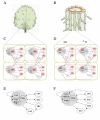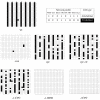Interlinked nonlinear subnetworks underlie the formation of robust cellular patterns in Arabidopsis epidermis: a dynamic spatial model
- PMID: 19014692
- PMCID: PMC2600786
- DOI: 10.1186/1752-0509-2-98
Interlinked nonlinear subnetworks underlie the formation of robust cellular patterns in Arabidopsis epidermis: a dynamic spatial model
Abstract
Background: Dynamical models are instrumental for exploring the way information required to generate robust developmental patterns arises from complex interactions among genetic and non-genetic factors. We address this fundamental issue of developmental biology studying the leaf and root epidermis of Arabidopsis. We propose an experimentally-grounded model of gene regulatory networks (GRNs) that are coupled by protein diffusion and comprise a meta-GRN implemented on cellularised domains.
Results: Steady states of the meta-GRN model correspond to gene expression profiles typical of hair and non-hair epidermal cells. The simulations also render spatial patterns that match the cellular arrangements observed in root and leaf epidermis. As in actual plants, such patterns are robust in the face of diverse perturbations. We validated the model by checking that it also reproduced the patterns of reported mutants. The meta-GRN model shows that interlinked sub-networks contribute redundantly to the formation of robust hair patterns and permits to advance novel and testable predictions regarding the effect of cell shape, signalling pathways and additional gene interactions affecting spatial cell-patterning.
Conclusion: The spatial meta-GRN model integrates available experimental data and contributes to further understanding of the Arabidopsis epidermal system. It also provides a systems biology framework to explore the interplay among sub-networks of a GRN, cell-to-cell communication, cell shape and domain traits, which could help understanding of general aspects of patterning processes. For instance, our model suggests that the information needed for cell fate determination emerges from dynamic processes that depend upon molecular components inside and outside differentiating cells, suggesting that the classical distinction of lineage versus positional cell differentiation may be instrumental but rather artificial. It also suggests that interlinkage of nonlinear and redundant sub-networks in larger networks is important for pattern robustness. Pursuing dynamic analyses of larger (genomic) coupled networks is still not possible. A repertoire of well-characterised regulatory modules, like the one presented here, will, however, help to uncover general principles of the patterning-associated networks, as well as the peculiarities that originate diversity.
Figures





Similar articles
-
Single-cell and coupled GRN models of cell patterning in the Arabidopsis thaliana root stem cell niche.BMC Syst Biol. 2010 Oct 5;4:134. doi: 10.1186/1752-0509-4-134. BMC Syst Biol. 2010. PMID: 20920363 Free PMC article.
-
Dynamic models of epidermal patterning as an approach to plant eco-evo-devo.Curr Opin Plant Biol. 2013 Feb;16(1):11-8. doi: 10.1016/j.pbi.2012.11.005. Epub 2012 Dec 6. Curr Opin Plant Biol. 2013. PMID: 23219864 Review.
-
Novel epidermal-cortical pattern and root apical silencing of VcCPC promoter activity in Arabidopsis might suggest a joint contribution to hairless roots in blueberry.BMC Plant Biol. 2025 May 24;25(1):694. doi: 10.1186/s12870-025-06744-y. BMC Plant Biol. 2025. PMID: 40413444 Free PMC article.
-
Equivalent genetic regulatory networks in different contexts recover contrasting spatial cell patterns that resemble those in Arabidopsis root and leaf epidermis: a dynamic model.Int J Dev Biol. 2007;51(2):139-55. doi: 10.1387/ijdb.062183mb. Int J Dev Biol. 2007. PMID: 17294365
-
The gene regulatory network for root epidermal cell-type pattern formation in Arabidopsis.J Exp Bot. 2009;60(5):1515-21. doi: 10.1093/jxb/ern339. Epub 2009 Jan 27. J Exp Bot. 2009. PMID: 19174459 Free PMC article. Review.
Cited by
-
Evolving sensitivity balances Boolean Networks.PLoS One. 2012;7(5):e36010. doi: 10.1371/journal.pone.0036010. Epub 2012 May 7. PLoS One. 2012. PMID: 22586459 Free PMC article.
-
Boolean networks as modeling framework.Front Plant Sci. 2012 Aug 15;3:178. doi: 10.3389/fpls.2012.00178. eCollection 2012. Front Plant Sci. 2012. PMID: 22912642 Free PMC article.
-
Single-cell and coupled GRN models of cell patterning in the Arabidopsis thaliana root stem cell niche.BMC Syst Biol. 2010 Oct 5;4:134. doi: 10.1186/1752-0509-4-134. BMC Syst Biol. 2010. PMID: 20920363 Free PMC article.
-
Mechanical forces as information: an integrated approach to plant and animal development.Front Plant Sci. 2014 Jun 10;5:265. doi: 10.3389/fpls.2014.00265. eCollection 2014. Front Plant Sci. 2014. PMID: 24959170 Free PMC article. Review.
-
Comparative expression analysis in three Brassicaceae species revealed compensatory changes of the underlying gene regulatory network.Front Plant Sci. 2023 Jan 4;13:1086004. doi: 10.3389/fpls.2022.1086004. eCollection 2022. Front Plant Sci. 2023. PMID: 36684738 Free PMC article.
References
-
- Dover G. Dear Mr Darwin: Letters on the Evolution of Life and Human Nature. University of California Press; 2006.
Publication types
MeSH terms
Substances
LinkOut - more resources
Full Text Sources
Research Materials
Miscellaneous

